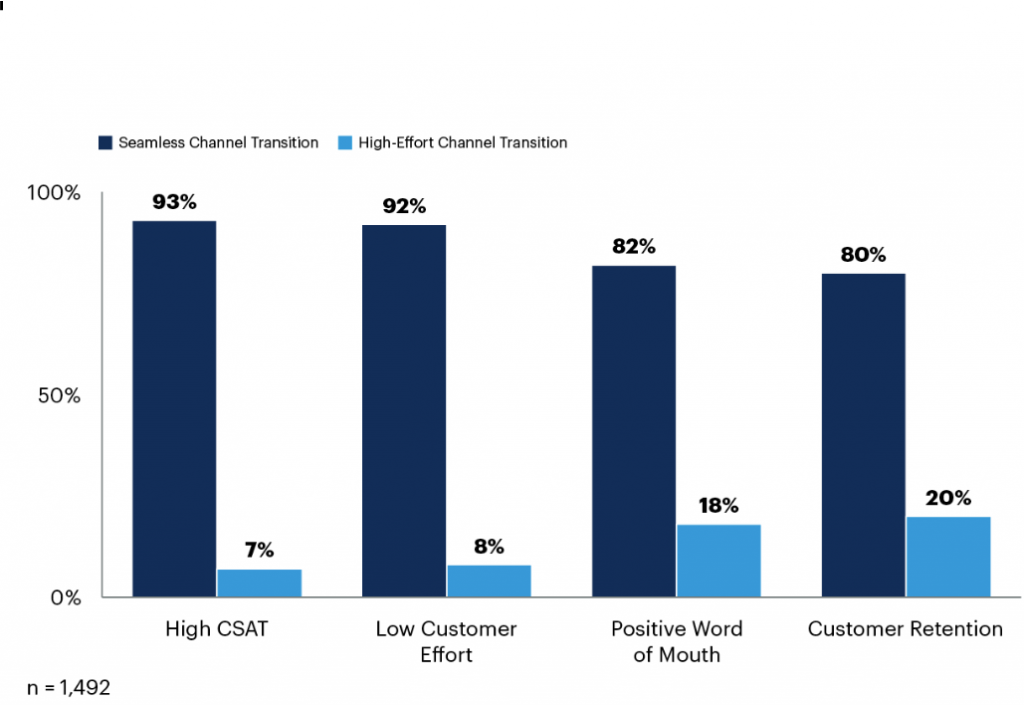Sixty-two percent of customer service channel transitions are “high-effort” for customers, according to Gartner, Inc. Less than half of customers who experience a high-effort transition will use self-service again for their next interaction.
A Gartner survey of 1,492 B2B and B2C customers in December 2022 found that a seamless transition between channels is a key driver of positive customer experience (CX) outcomes and future self-service adoption. When the transition is high-effort, meaning that switching channels did not lead to resolution, the probability of positive CX and loyalty outcomes is dismal.
“Many customer service and support leaders worry that creating easy transitions to assisted channels will undermine their self-service goals,” said Eric Keller, Senior Director, Research in the Gartner Customer Service & Support practice “Our research shows the opposite is true: 74% of customers who experience easy transitions to a customer service rep say they’ll return to self-service next time.
“Despite resolving their issue in assisted service, these customers are just as likely to use self-service in the future as those whose issues were fully resolved using self-service.”
Seamless Transitions Boost CX and Reduce Costs
The survey highlights the benefits of promoting seamless transitions between self-service and assisted channels. Seamless transitions improve CX across a range of metrics (see Figure 1) and boost loyalty, but they also save time and resources. In fact, 93% of respondents reported high customer satisfaction (CSAT) when there was a seamless channel transition. The survey found customers who experience seamless transitions from self-service to a rep spend 27% less time in assisted channels.
Figure 1. Seamless Transitions Improve CX Outcomes

Source: Gartner (June 2023)
In addition, customers who go on multichannel journeys with seamless transitions report less customer effort than the average customer who uses just one channel.
“Multi-channel customer service journeys are extremely common, and improving those channel transitions has a material impact on the bottom line,” said Keller. “Seamless transitions save an average of 4 minutes of costly rep time per customer journey because reps aren’t asking customers to repeat information they have already provided.”
With 88% of customer journeys starting in self-service touching multiple channels, customer service and support leaders must recognize that creating seamless transitions between those service channels is the key to their digital-first service ambitions.
To create low-effort multichannel journeys, customer service and support leaders should:
- Share customers’ context from self-service with reps. The steps customers take or information they provide in self-service is too often lost if they switch channels, with customers having to repeat themselves. Instead, companies should capture customers’ context in self-service (e.g., the FAQs they visited) and transfer that information to reps.
- Provide prescriptive channel guidance, not just choices. Whether it’s a digital interactive voice response (IVR), a case creation tool, or strategically placed chat pop-ups, organizations need to guide customers during channel transitions, rather than providing many choices and letting them find their own way.
- Make seamless transitions part of the messaging to customers as to why they should start in self-service. Customers will be more likely to try self-service when they know it will be easy to get more support if needed.
Gartner clients can read more in Deliver Seamless Customer Service Journeys Across Channels.
About Gartner for Customer Service & Support Leaders
The customer service and support function is vital to maintaining customer loyalty and influencing brand perceptions. Gartner for Customer Service & Support Leaders provides indispensable insights, advice and tools needed to achieve service and support leaders’ mission-critical priorities, specifically improving the customer experience while managing costs; designing an optimal service channel strategy; measuring and reducing customer effort; and how to hire, develop and retain high-potential frontline talent.
Visit https://www.gartner.com/